Becoming the Witch: How to awaken the wild sovereign within (Menaces of the Mind #5)
Rewilding the soul – break the old spells that keep you small
You can also listen to this piece on YouTube.
***
She lives at the edge of the forest, or deep inside it. She knows spellcasting and how to use what grows from the earth. She’s at one with the seasons and the stars. She does what she wants and cares not for the opinions of others. People fear her, but only because they can’t control her.
Do we not all want to be just a little more… Witch? And, if so, why do we resist?
The witch in myth and mind
In myth, fairytale and folklore, witches are powerful women — sometimes men, but usually women — who are feared for their independence. They heal, curse, protect, perform magic, and they refuse to be tamed.
Some of you might wonder how the Witch made it onto a list of monsters – and as you can probably tell from my tone, I agree that the Witch archetype is not demonic or evil in the slightest. She’s on this list because she has been portrayed as monstrous for thousands of years – as the wart-nosed cackling menace who cannot be trusted. In short, historically at least, we’re supposed to see the witch as a monster.
We’re supposed to stay away, but that doesn’t mean that we should.
In terms of archetypal psychology, the Witch represents sovereign intuition — the wild wisdom that hegemonic systems have tried to domesticate for centuries, and have been fairly successful in doing so, too. But not entirely successful, because the Witch is one of the most enduring, fascinating, polarising archetypal figures we know. And she ain’t going anywhere.
Today, we’re exploring how we can all awaken the energy of the Witch within (regardless of whether we’re interested in anything like herbalism or paganism) and what we can gain from doing so.
Witchy pronouns?
First, a note: In many of my articles, I have de-gendered the archetypes’ external shells – their avatars – to make them more accessible to men, women and nonbinary people alike: the Maiden becomes the Tenderfoot, the Hero becomes the Warrior, the Crone becomes the Seer, etc. This doesn’t mean I’m denying the feminine and masculine traits wrapped up in the different archetypes, just that I don’t see the point of confining universal human energies to physical bodies that only, at most, 50% of people can readily identify with.
Having said that, I’m not going to de-gender the Witch because she is so important to the history of women and feminism. But that doesn’t mean this archetype isn’t available to those who identify as either nonbinary or male. Because she is available, and important. In fact, men, I especially invite you to embrace your inner Witch. She has a lot to offer us all.
The Witch is the wilder part of all of us that lives at the vital threshold between the mundane, familiar conscious world, and the magical, mysterious forest of the unconscious.
She is a way into a place where inner knowing bubbles up to eclipse societal expectation and the need for approval. And that, my friends, is genuine magic.
Witch Trials and Shadow Projections
Let’s address the elephant in the room.
The witch trials were a historical campaign of persecution – mostly between the 15th and 18th centuries – during which thousands of people (primarily women) were accused of witchcraft and brutally punished and/or executed. Scholars estimate between 30,000 and 60,000 people (again, mostly women) were lost during this time.
But the witch hunts weren’t really about magic. They were about control: a way for patriarchal and religious powers to suppress those who defied social norms – especially independent, outspoken, or unconventional women.
Historians such as Carolyn Merchant and Silvia Federici write about how the witch hunts were a systematic tool of social control. By demonising women’s knowledge of the body, of herbs, of cycles, and of community during the Scientific Revolution, patriarchal and economic powers dismantled the older, earth-connected ways of life and replaced them with hierarchy and obedience – a social structure within which the Witch and all that she stands for not only had no place, but became taboo.
Viewed through this lens, we can see that the trials functioned as collective shadow projections, scapegoating individuals who demonstrated things like instinct, autonomy, sexuality, and spiritual knowledge – the potent, truth-bearing aspects of humanity that couldn’t be subjugated and thus posed a threat to the governing system.
What it all boils down to is this: the Witch was never the danger; she was the mirror that society could not stand to look in.
Centuries have passed since the trials, but those old warnings live on in quieter forms today. We can hear them every time someone tells us to tone it down, to be ‘nice,’ to play small. Thankfully, though, not everyone listens to these injunctions.
Modern-day witch culture, argues India Rakusen on the BBC Sounds podcast Witch, can be seen as a powerful movement for renouncing the trials and the subjugation of the feminine in the past and present. There’s “a certain perverse pleasure,” she says, “as well as a sense of rightness and beauty, in insisting on flowering just when the world expects you to become quiet and diminish”.
This is the call of the Witch – she shows us the cost and necessity of reclaiming our authentic instincts, depths and wisdom.
Beware the lure of the Disempowered Hermit
Note: I’m including “disempowered” to differentiate between the Hermit/Sage archetype – a wise recluse – and what we’re discussing here.
So, how do we go about reclaiming this bigness of self? The first step is to face the Witch’s antagonistic opposite – that which tries to keep us small.
The Witch archetype’s passive shadow side is the Disempowered Hermit – the disconnected recluse who retreats to the cabin in the woods to be alone, rather than to gleefully concoct her magic spells. The Hermit does not own or acknowledge her power. She doesn’t choose life or magic or knowledge, because she prefers to stay small and quiet and unseen, as the world wants her to be.
To deny the inner Witch is to retreat into one’s inner hermitage, and it’s all too easily done. The Hermit is the result of allowing ourselves to be reduced and confined by the warnings we internalise over the course of our lives:
Don’t speak too loudly or want too much.
Don’t be too strange, too angry, too clever, too powerful.
Don’t let them see the fire in your belly, or the hunger in your eyes.
And for the love of god, don’t cackle at your own jokes.
It might sound relatively innocuous – even peaceful – to give up the fight and go off to live a quiet life in a log cabin with a few cats and a good book, but of course that’s not how it works out when the Hermit hasn’t been chosen but forced. The Witch within refuses this fate – so she whispers in our ears while we try to sleep, attempting to nudge us back into our wildness from her place in the dark. As with all shadow parts – that is, the resisted parts of the self – if we try to ignore her rebellious, nonconformist calls, she can actually start to feel quite monstrous.
Beware the madness of the Shadow Witch
The resisted Witch archetype – the Shadow Witch – makes us think and act in ways that feel irrational, unattractive, ridiculous, unacceptable. To awaken the Wild Sovereign autonomously – to own our instincts and opinions and power in a way that doesn’t feel horribly othering – means renouncing the imposed rules and expectations that try to minimise these things, and shining a new, brighter, better light on the Witch so we can use her magic for positive change.
Put differently, we need to replace the hypnotising sorcery of our social conditioning with some realer, wiser, better spells.
Undoing the darker magic
At some point in your life – probably early on when you were still soft and pliable – someone looked at your bigness and flinched. At that moment, a spell was cast. Maybe it was a parent, a teacher, a group of kids at school. Maybe it wasn’t spoken outright, just implied with a glance, a turned back, a door that was quietly closed.
These spells go something like this:
“No one likes a show-off.”
“You’re being dramatic.”
“Calm down.”
“Be quiet.”
“Why can’t you just be normal?”
Though usually well-meant, these aren’t spells of protection; they’re spells of containment, designed not to keep you safe so much as to keep you small. Regardless of whether we’re into this Witch metaphor, we need to rewrite these old spells.
The dark spell you still obey
So now, I invite you to pause. I’m going to ask you some questions about the times and places you might have received diminishing messages while you were younger. If this doesn’t feel safe, take a step back.
If it does, though, close your eyes if you can, and ask yourself this:
What’s one dark spell that has been cast upon me?
What’s one thing I was told – directly or indirectly – that made me shrink?
You may remember moments rather than messages you can put into words – times when you were told off at home or at school, happenings or events that made you feel humiliated, less-than, or like you had to hide yourself away.
When it’s safe to do so, most of us can usually come up with these memories fairly easily, and we know when we’ve found them because they still sting. Even if the old criticism or warning sounds childish, silly and outdated to our adult ears, something about it remains uncomfortable all the same. That’s how you know it’s real. That’s how you know the spell stuck.
If you have an idea of a spell of containment that was cast on you, just notice it. It might come to you as an image, a sound, a feeling, taste or smell… It may be clear or it may be vague, and it may be something you can put into words, but it doesn’t have to be.
Whatever you’re noticing right now – however you’re noticing it – label it, if you like, as something that was never your truth, never reality, just someone else’s fear.
And then take a breath so we can invite the Witch forward.
The counter-spell
Witches in folklore were often healers, midwives, wise women. The village came to them in secret – for tinctures, for prayers, for truth, or to be challenged, tested, initiated.
To reclaim the Witch within is to reclaim our right to step back and question what we are told – to recover the right to know for ourselves and to be ourselves — even when no one claps for it. Especially then.
The magic the Witch wields is made of consciousness, awareness and truth. When the light of this magic is cast upon old messages, they come undone, because awareness is the starting point of every new spell, and the breaking point of every old curse.
The Witch is able to take the dark spells forced upon all of us and turn them on their heads.
Meet the Witch. Hear her cackle.
Imagine, if you will, a young warrior journeying to the cabin in the woods seeking help with a spell of confinement. Chin high but heart pounding, they approach the Witch’s door and knock. The door swings open of its own volition, and the black cat watches from its place in the corner – amber eyes, shrewd and unflinching – as the warrior ventures into the gloom to find the old, wizened woman pottering around the stove, weighing herbs and stirring some strange boiling concoction. She speaks without needing to turn and see her guest. “What have you brought me, then? Spit it out, child.”
Imagine the warrior laying their curses out on the battered old table – spelling out the words that once felt so powerful. First, “No one likes a show-off,” then “Don’t be so dramatic,” and finally, “Why can’t you just be normal?”
Let’s pause here, and give this a moment. How does the Witch respond to these messages? Does she soften, comfort the warrior, placate them? Does she hesitate, weighing the ideas against the rational reality of the world? No. Of course not. The Witch looks down her crooked nose at the fragile little words on the table and she laughs. It’s not that she doesn’t care that the warrior suffers; it’s that, from her dwelling in the forest — in the raw, bare truth of the natural world — these ideas mean nothing to her. Nothing.
“No one likes a show-off?” she says, voice crackling like firewood. “Then let them look away. The sun doesn’t dim itself for fragile eyes and neither should you.” She flicks a pinch of tarragon into the cauldron, and the first cursed phrase burns to ash as she moves on to the next.
“Don’t be dramatic?” She scoffs, shoulders shaking. “My dear, drama is divine. The sky weeps, the sea rages, the earth quakes — and you think you’re meant to smile sweetly through it all? Nonsense. Feel fully, or don’t bother feeling at all.” With a dismissive flick of the wrist, the little words erupt into an explosion of purple flame, and then they’re gone.
The old crone looks towards the final spell. “Why can’t you just be normal?” The Witch freezes at this. Then, slowly, she turns to face the warrior. Her voice is low now, almost reverent. “Normal…” she repeats, tasting the word like something sour on her tongue. “I have watched ‘normal’ break more souls than war or famine. ‘Normal’ is the grey mask they hand you the moment you begin to shine. It’s the binding spell. The shrinking spell. The spell of domesticity.”
She leans in, so close the warrior can smell the smoke in her breath. “You were never meant to be normal, child. You were meant to be free. You were meant to be fierce. You were meant to be magic. And magic,” she hisses, “has never once followed the rules.”
Choosing the wise freedom
Now, I’m not here to tell you how the Witch would respond to your old curses. Only you can know that, really. Whether you let her cast your new spell right now, or whether you let her wisdom bubble up slowly over the coming days, doesn’t really matter, just that you do question the rules you were taught to follow. Question the things you were taught to fear. Because the Witch knows that you are not too loud or too wild or too opinionated or too rash. You’re not too anything. And you know it as well, do you not? The very same things that made them flinch are the things that will make you free.
The Wild Sovereign Witch does not ask you to be wicked, she asks you to be whole. And wholeness will always be too big for a world that prefers us tame.
So, please take every opportunity you have to incinerate and rewrite all the old curses that try to keep you small. The only question for now is this: which spell will you choose to break first? Tell me, so we can cackle at the fragile old words together.
–-----------
References:
Carolyn Merchant, ‘The Death of Nature: Women, Ecology and the Scientific Revolution’
Silvia Federici, ‘Caliban and the Witch: Women, the Body and Primitive Accumulation’
India Rakusen, ‘Witch’ podcast, BBC Sounds
Carl Jung, ‘Archetypes and the Collective Unconscious’
Clarissa Pinkola Estés, ‘Women Who Run With the Wolves’



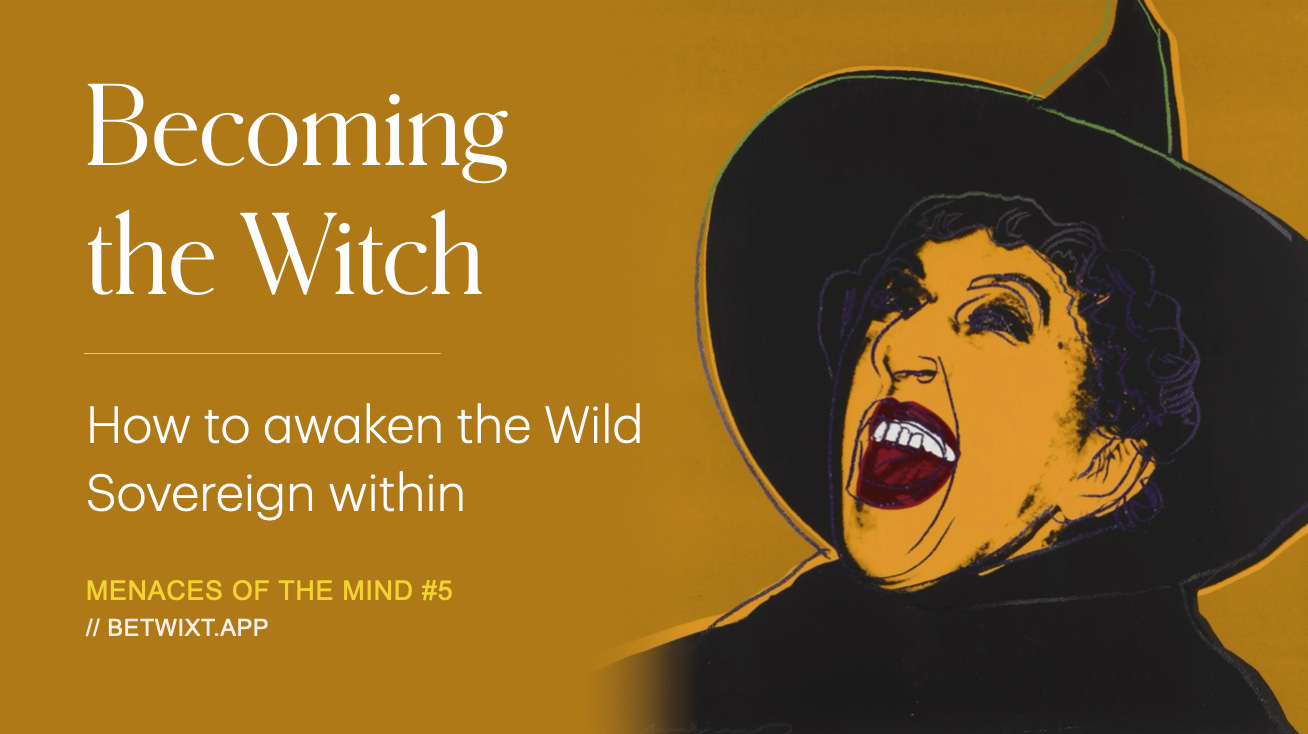
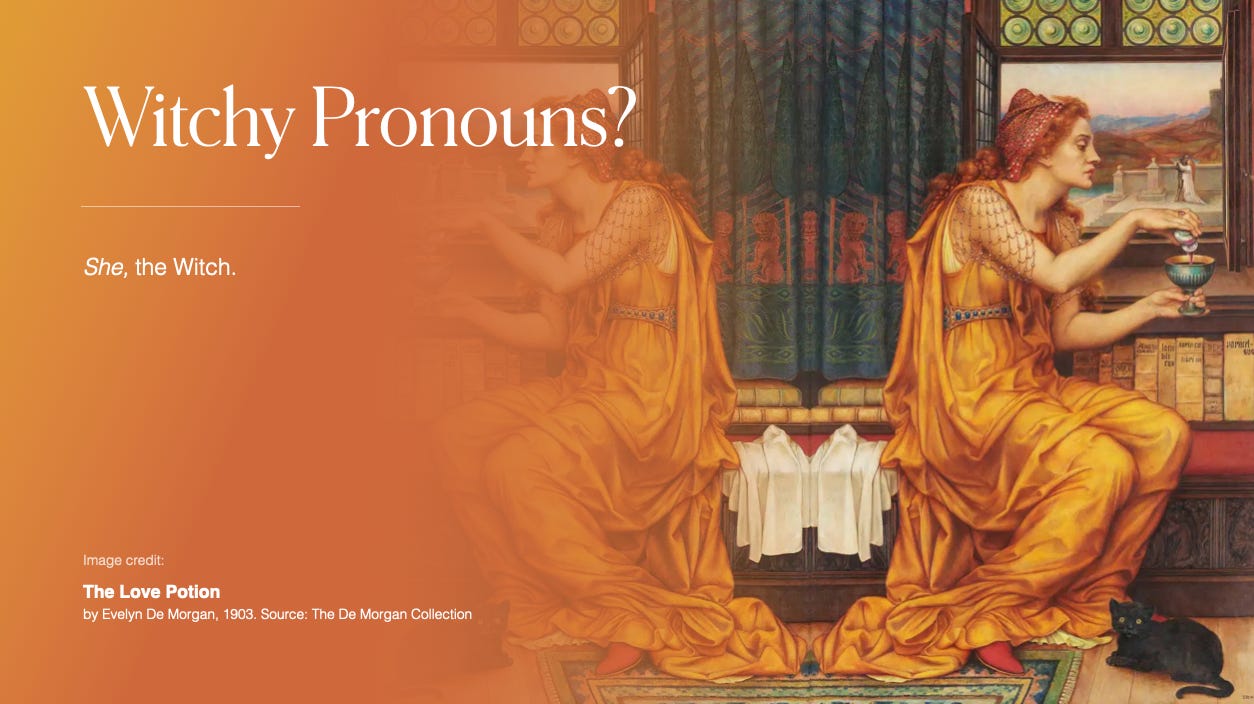
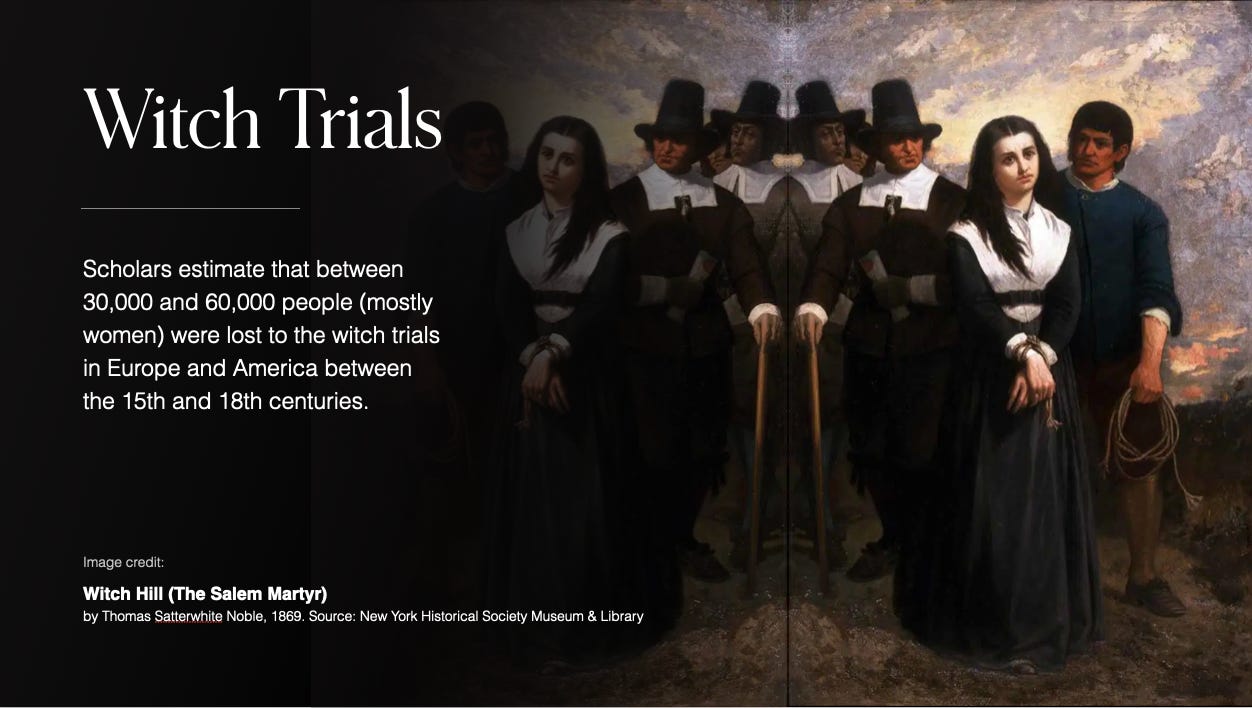
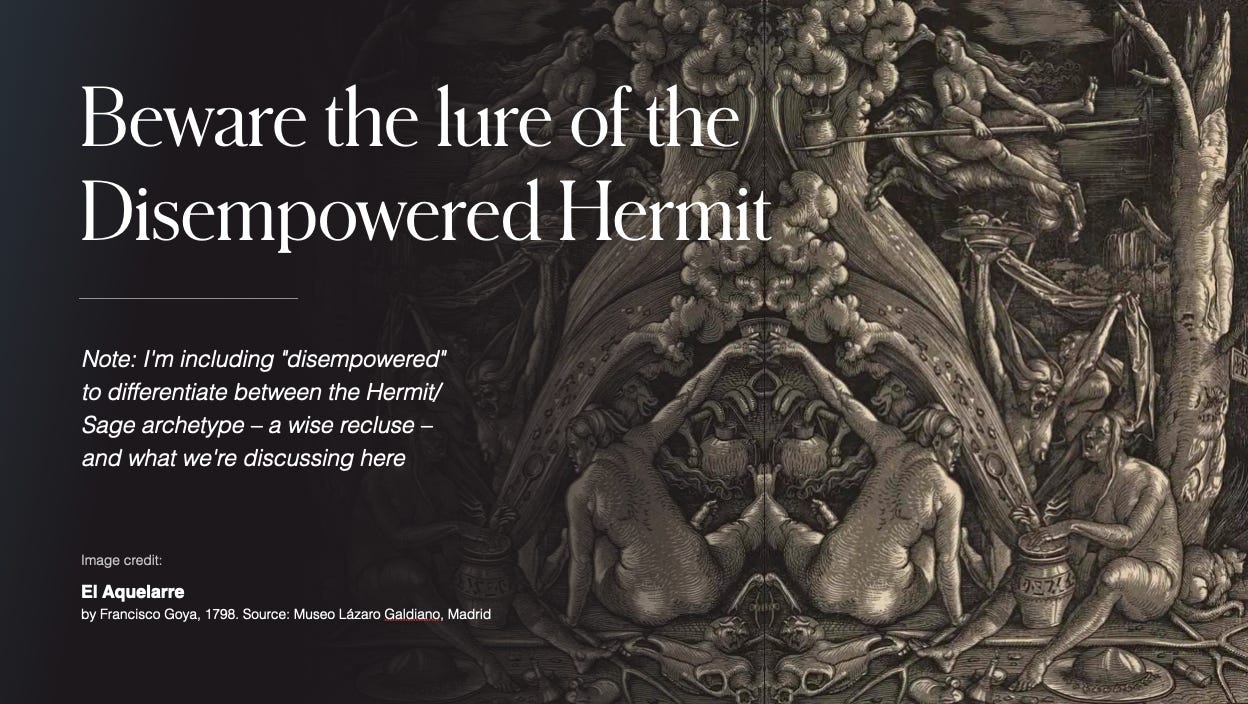
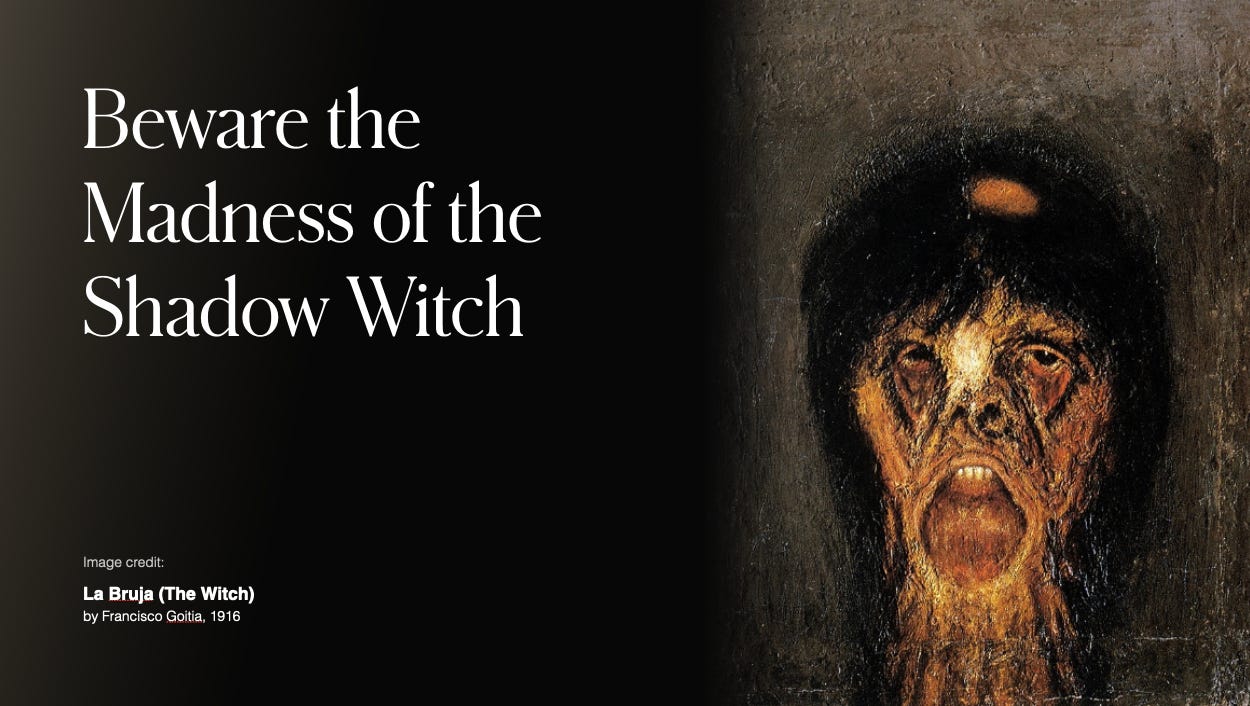
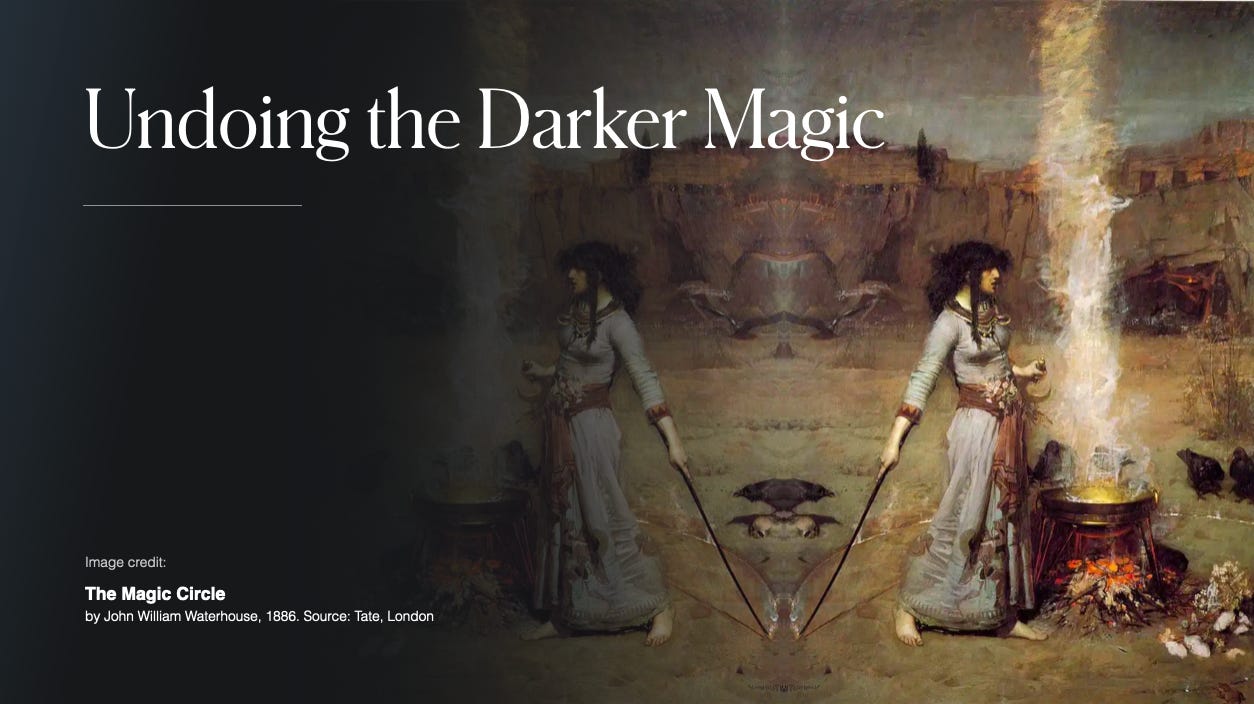
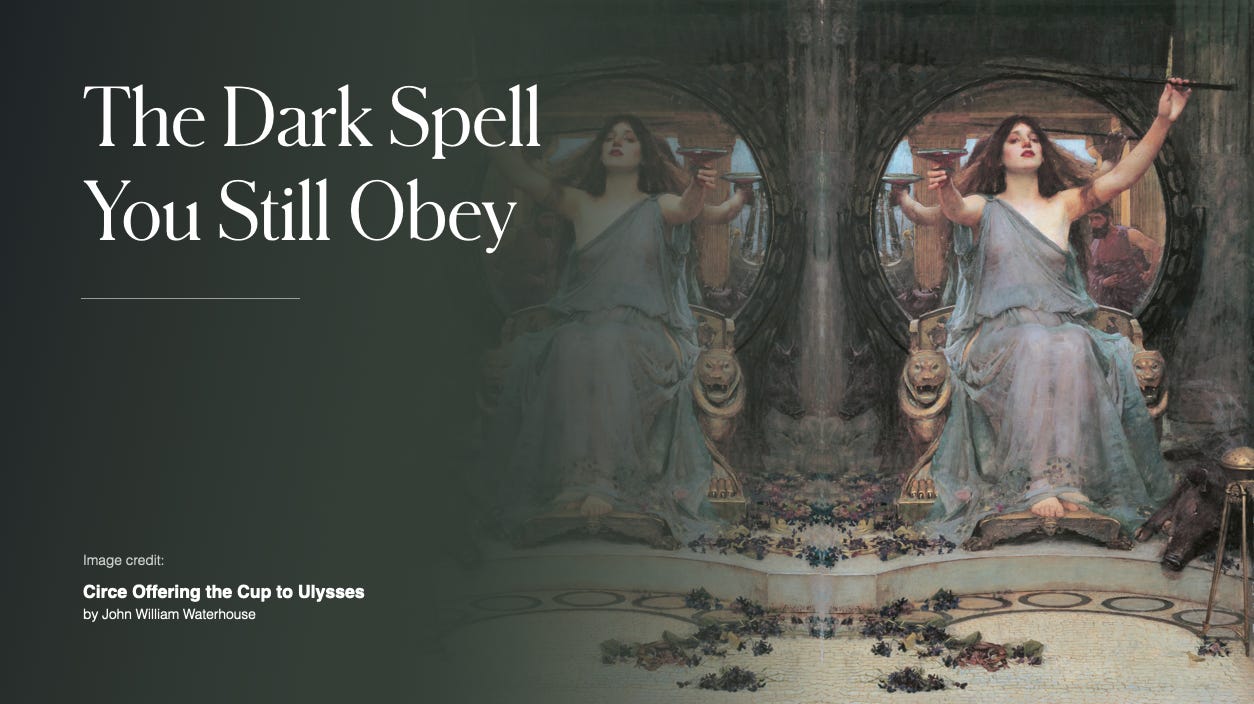
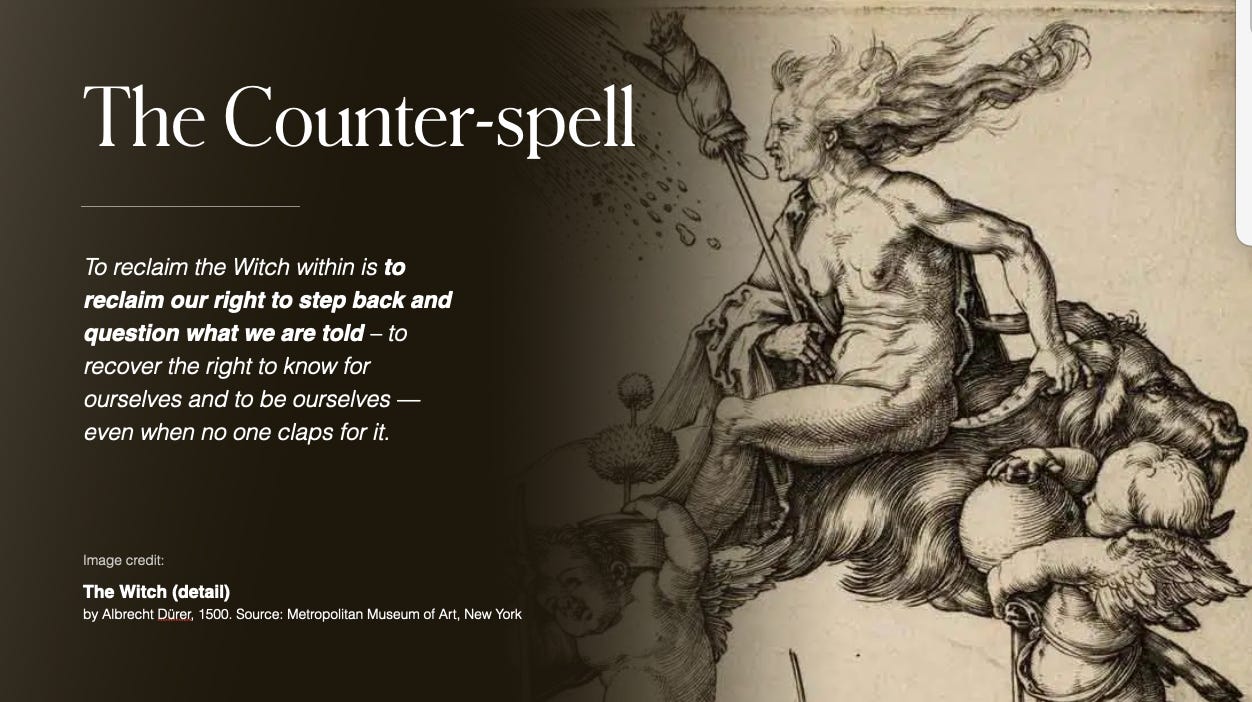
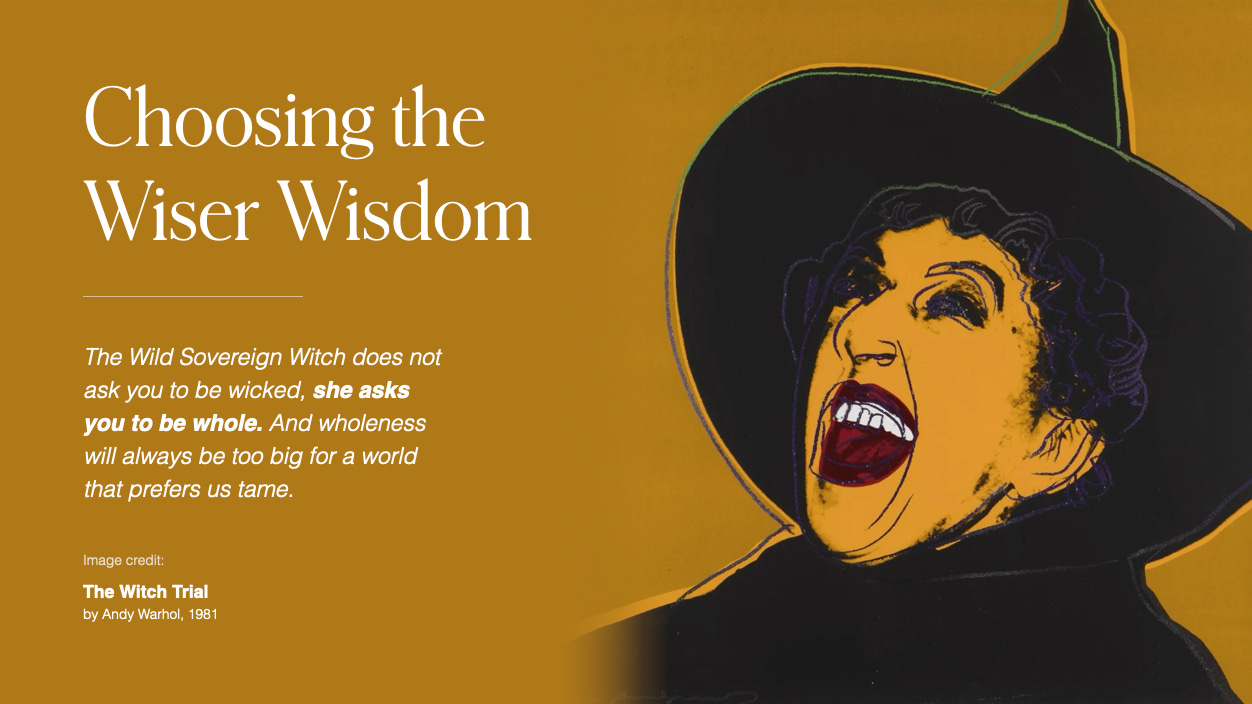
“Feel fully, or don’t bother feeling at all.” THIS.
I might have thought this of every piece of the series but this one is my favorite! How synchronistic, I was thinking exactly about the consequences of the Inquisition period the other day (I shed a tear or two) and the impact it still has on human beings and you wrote "Centuries have passed since the trials, but those old warnings live on in quieter forms today. We can hear them every time someone tells us to tone it down, to be ‘nice,’ to play small. Thankfully, though, not everyone listens to these injunctions." And that's so true, I feel like the Witch within all is awakening and this time, no attempt to control us will work... this time fear won't get a hold of us, but wisdom.
The final part of the article is brilliant, pure poetry and magic. Let's have a light-hearted laugh and keep moving forward! Thank you for your work!